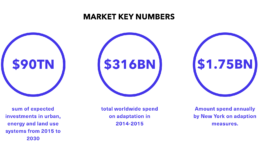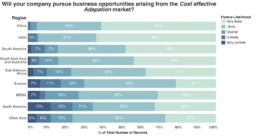The necessary expenditure on climate adaptation can be turned into pioneering projects creating a more sustainable future.
Addressing extreme weather need not be costly. In fact, adopting sustainability measures in order to build resilience against extreme weather can generate a variety of co-benefits for a small additional cost. Relevant initiatives range from investments in public transport and renewable energy generation to creating city parks or developing coastal wetlands, which will also protect freshwater resources. What ties all of these components together is the wealth of potential benefits that can result from them, including more attractive cityscapes, increased biodiversity, and reduced public health expenses.

A recent study estimated that between now and 2030, investments in urban, energy, and land use systems will amount to 90 trillion USD. Adding just 0.5 percent to this figure could turn this expense into an agent of active change towards a more efficient and sustainable economy. Moreover, the extra cost can often be offset by the energy savings and other benefits that result from putting societies on a more sustainable trajectory. An example is redirecting traffic from the city center to create more green areas. This will help the city cope with extreme downpours or foods while at the same time create health benefits by lowering air pollution.
A recent study estimated that between now and 2030, investments in urban, energy, and land use systems will amount to 90 trillion USD. Adding just 0.5 percent to this figure could turn this expense into an agent of active change towards a more efficient and sustainable economy. Moreover, the extra cost can often be offset by the energy savings and other benefits that result from putting societies on a more sustainable trajectory. An example is redirecting traffic from the city center to create more green areas. This will help the city cope with extreme downpours or foods while at the same time create health benefits by lowering air pollution.
Survey Findings
The market opportunity Cost-Effective Adaptation sees great variance in rating among geographic regions. In India, respondents are very positive when assessing its potential for positive impact on society. However, in Sub-Saharan Africa and Other Asia it is rated as the less favorably on this scale and this opinion is also echoed among the respondents from China.

Respondents place the greatest confidence in this market opportunity’s potential in lower-middle-income economies. Mirroring its performance between regions, it is one of the opportunities with the greatest divergence in rating between economies. It gets the most positive responses from respondents in the lower-middle-income economies and weaker backing in upper-middle and high-income economies.
Respondents see civil society stakeholders as the most supportive stakeholder group for this opportunity, while stakeholders in politics are the least supportive.

When surveyed across business sectors for its impact on business, then this market opportunity receives mediocre ratings, and in particular the “other business” sector is least positive about its impact on business.
This market was surveyed globally in 2014 by more than 5500 leaders from both the public and private sectors. The survey was conducted in collaboration with the research company YouGov. The survey results were originally published in the Global Opportunity Report 2015.

